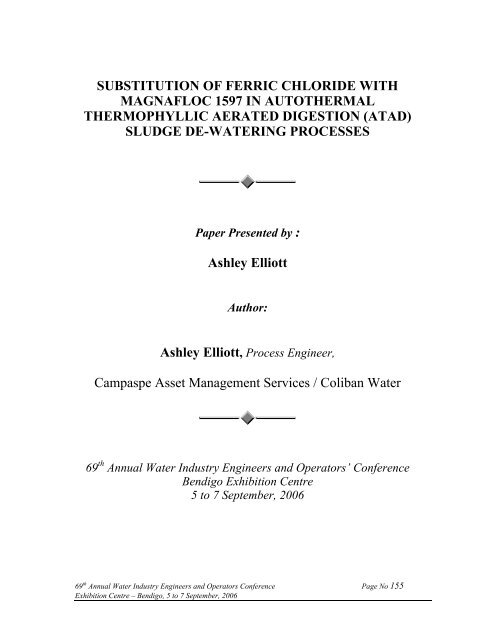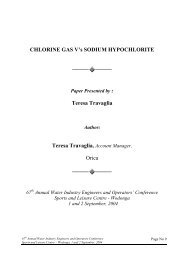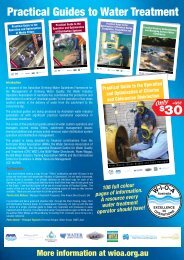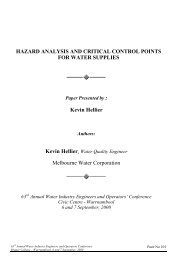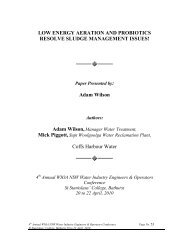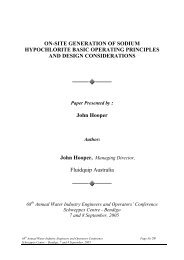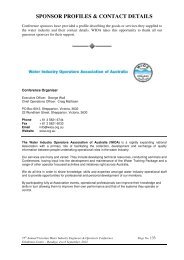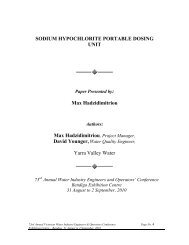SUBSTITUTION OF FERRIC CHLORIDE WITH ... - WIOA
SUBSTITUTION OF FERRIC CHLORIDE WITH ... - WIOA
SUBSTITUTION OF FERRIC CHLORIDE WITH ... - WIOA
You also want an ePaper? Increase the reach of your titles
YUMPU automatically turns print PDFs into web optimized ePapers that Google loves.
<strong>SUBSTITUTION</strong> <strong>OF</strong> <strong>FERRIC</strong> <strong>CHLORIDE</strong> <strong>WITH</strong>MAGNAFLOC 1597 IN AUTOTHERMALTHERMOPHYLLIC AERATED DIGESTION (ATAD)SLUDGE DE-WATERING PROCESSESPaper Presented by :Ashley ElliottAuthor:Ashley Elliott, Process Engineer,Campaspe Asset Management Services / Coliban Water69 th Annual Water Industry Engineers and Operators’ ConferenceBendigo Exhibition Centre5 to 7 September, 200669 th Annual Water Industry Engineers and Operators Conference Page No 155Exhibition Centre – Bendigo, 5 to 7 September, 2006
through the use of centrifuge technology was increased dry solids content of the dewateredsludge. Centrate from the facility was again treated off the immediate site.2.4 Chemical Selection ProcessOne of the sites current chemical suppliers included Ciba Speciality Chemicals Pty Ltd.Through extensive consultation with this company an alternate flocculant/coagulant toferric chloride was to be sourced.The chemical had to deliver on a number of key performance criteria;• non-hazardous and non-corrosive• the ability to deliver the equivalent de-watering characteristics as ferric chloride• be cost equivalent or betterCiba, after extensive overseas research, recommended and sourced a product that had yetto be used in Australia with ATAD sludges. This product was Magnafloc 1597.2.5 Product TrialsBoth ferric chloride and the new product Magnafloc 1597 were trialled through thecentrifuge for several months to ascertain the suitability of Magnafloc 1597 to deliver onthe performance criteria. These trials were implemented jointly by CAMS and Ciba.Product SafetyA detailed assessment of the properties of both products indicated that Magnafloc wasable to deliver on first performance criteria. The outcome of a product comparison isdetailed in Table 1.Table 1: MSDS Comparison of Ferric Chloride to Magnafloc 1597Criteria Ferric Chloride Magnafloc 1597Active Ingredient Ferric chloride Low mol wt cationic resinMolecular Structure Inorganic OrganicDangerous Good Yes NoHazardous Yes NoSafety Risks Moderate LowVentilation/ Respiration Yes when aerosolised/misted Yes when aerosolised/mistedEnvironmental Impact High ModerateIt was also noted that whilst vapours were generated through the operation of thecentrifuge using Magnafloc 1597 exposure to these vapours was less hazardous asindicated by the MSDS. Anecdotal evidence from operations staff performing the trialsindicated that offensive vapour levels were not experienced when using the Magnafloc1597 product.De-watering CharacteristicsBoth agents were good sludge conditioners, producing a sludge cake in the order of 18-23% dry solids. Only one adverse difference was seen in using the two chemicals.Significant quality differences were seen within the centrate.69 th Annual Water Industry Engineers and Operators Conference Page No 159Exhibition Centre – Bendigo, 5 to 7 September, 2006
Table 2:Average Centrate ParametersParameter Ferric Chloride Magnafloc 1597pH 4.0-5.0 8.0-9.0Iron 230 mg/L 3 mg/LPhosphorus 55 mg/L 510 mg/LAlkalinity 1000-1200 mg/L 1800-3000mg/LCOD 5000-6000 mg/L 4000-6000 mg/LAmmonia 1300-1600 mg/L 800-1500 mg/LAs outlined in Table 2 centrate quality varied significantly with three parameters only.The pH of the centrate when using ferric chloride was in the range of 4.0-5.0 compared to8.0-9.0 for Magnafloc 1597. This pH shift in using the new product benefited two areasof operation, less corrosive and more effective centrate treatment.The second parameter of significance was iron. The iron content of the centrate producedusing Magnafloc 1597 was in the order of 100 times less.Concentrations of iron in the sludge were reduced by six fold when using Magnafloc1597. This allowed for a significant reduction in the iron content of the end productbiosolids. This reduction was seen as a future advantage in maintaining a commerciallyviable agricultural product when minimal research has been conducted on the impacts ofiron within soils.Iron (Fe) LevelsIron (Fe) Levels25070000Concentration (mg/l)20015010050FerricMagnaflocConcentration (mg/kg)600005000040000300002000010000FerricMagnafloc0Average Centrate0Average SludgeFigure 7: Iron Content of CentrateFigure 8: Iron Content of SludgeThe third parameter of significance was phosphorus. The phosphorus content of thecentrate produced using Magnafloc 1597 was in the order of 10 times more. This was aresult of ferric chloride having a significantly greater binding capacity of phosphoruswithin the sludge.During the course of the trial it was decided that to effectively treat the centrate this flowwould be redirected from the off site treatment area to the head of works. As the BendigoWRP process is BNR the treatment of phosphorus levels within the centrate had toachievable. It was found during the course of the trial that the biological processremoved a proportion of this phosphorus. Residual phosphorus moving through the plant69 th Annual Water Industry Engineers and Operators Conference Page No 160Exhibition Centre – Bendigo, 5 to 7 September, 2006
was effectively removed through the addition of alum at the tertiary process.2.6 CostsIt was found that significantly less Magnafloc 1597 is required to achieve the same cakesolids when using ferric chloride. The equivalent dose rates for ferric chloride andMagnafloc 1597 are detailed in Table 3.Table 3: Dose Rates for Ferric Chloride Compared to Magnafloc 1597ChemicalDose Rate(tonne/tonne dry solids)Ferric chloride 0.50Magnafloc 1597 0.10However Magnafloc 1597 is around six times the cost of ferric chloride. During thecourse of the trial it was found that the change over to Magnafloc 1597 was cost neutral.Any financial gains in flocculant/coagulant savings have been absorbed by additionalalum dosing to remove phosphorus in the centrate treatment. In the future it isanticipated that more efficient BNR treatment will present as cost savings within thebusiness.3.0 CONCLUSIONAfter extensive trials of ferric chloride and Magnafloc 1597 using centrifuge de-wateringa clear decision on the preferred chemical was made. The selection of Magnafloc 1597over ferric chloride was chosen principally on OHS grounds to improve the workingenvironment of the operational staff. Minimal changes have been shown to the sludgede-watering characteristics when using either ferric chloride or Magnafloc 1597.Negligible cost impacts were realised.As a consequence of delivering on all performance criteria Magnafloc 1597 replacedferric chloride at the Bendigo WRP de-watering facility.4.0 ACKNOWLEDGEMENTSThe author acknowledges the operational staff at the Bendigo Water Reclamation Plantfor their participation and consideration in the process of changing over to Magnafloc1597.A special thanks to Jamiel Muhor of Ciba Specialty Chemicals Pty Ltd for his expertiseand assistance in the trialling of Magnafloc 1597.Coliban Water and Campaspe Asset Management Services.5.0 REFERENCESMaterial Safety Data Sheet (MSDS) Ferric Chloride Solution Orica Chemicals, 31/3/2003version 269 th Annual Water Industry Engineers and Operators Conference Page No 161Exhibition Centre – Bendigo, 5 to 7 September, 2006
Material Safety Data Sheet (MSDS) Magnafloc 1597 Ciba, September 2003, version 2Orica Bulk Installation Guide Ferric/Ferrous Chloride, 13/07/2001.69 th Annual Water Industry Engineers and Operators Conference Page No 162Exhibition Centre – Bendigo, 5 to 7 September, 2006


